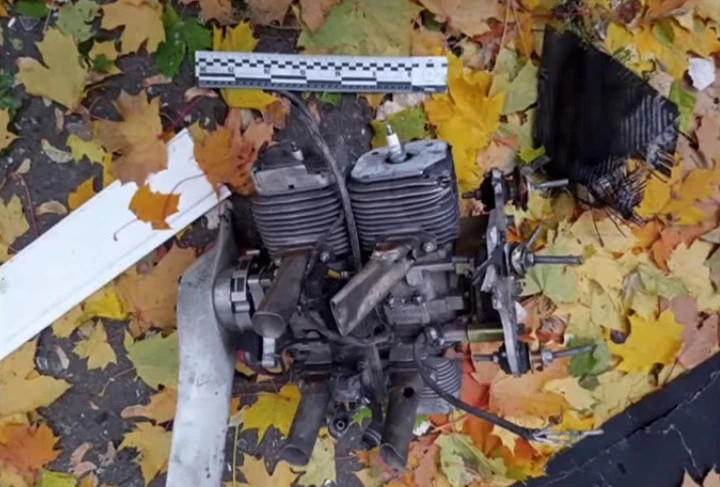
Night Shahed attack on Kyiv, Zelenskyy's Victory Plan, and Tomahawk missiles. Serhiy Zgurets' column
On October 30, a Shahed attack on Kyiv caused casualties and damage; Zelenskyy reportedly requested Tomahawk missiles from the U.S.
Russia's Shahed attack on Ukraine on night of October 30
Russia continues its systematic terror against civilians, launching attacks on Ukrainian regions overnight using Shahed drones. A total of ten regions, including the capital, were targeted. Reports indicate that Russia deployed 62 attack drones, with 33 being intercepted and 25 lost locally, suggesting these may have been drones designed to mimic Shaheds.
What details have we received from our sources related to this attack: we have seen photos of the wreckage of the Shahed drones that were shot down over the capital yesterday.

One of the fragments recovered bears the number I 8022, which corresponds to the serial number of Shaheds produced at a facility in the Russian Federation. This suggests that Russia has increased its production rate of Shahed drones, with estimates now exceeding 8,000 manufactured units. Experts analyzing the wreckage indicate that it's unlikely the Russians are falsifying these figures, as there has indeed been a noticeable increase in the number of Shaheds recently.

An analysis of the engines used in the Shahed drones reveals that they have been significantly simplified. While these engines are primarily Chinese-made, they are missing certain components, such as a starter and flywheel. This indicates that Russia is employing these makeshift versions of the original Shaheds to boost the production of unmanned attack drones, allowing them to increase their numbers despite the limitations in quality and functionality.
What conclusions do we draw from this? In other words, the Russians have intensified their attacks on Ukrainian regions, using Shaheds, Geraniums, Gerberas, and other versions of drones used for strikes. The question is how to find an effective response. Now the main burden falls on mobile units that hunt for the Shaheds, on air defense, and on man-portable air defense systems used to destroy the Shaheds.
Ukraine faces the critical challenge of balancing cost-effectiveness in its defense strategy against the constant threat posed by Shahed drones. With each Shahed costing approximately $200,000, the aim is to avoid using more expensive means, such as anti-aircraft missile systems, to destroy them. This necessitates finding alternative solutions that effectively mitigate the impact of these drone attacks on civilian areas while managing resources efficiently. The ongoing search for such strategies is crucial for maintaining the safety of Ukrainian cities and villages amid persistent Russian aggression.
International community's view on Zelenskyy's Victory Plan
There are a lot of reports based on Zelenskyy's press conference for the European media, with many critical statements about Ukraine's partners. Oleksiy Yizhak, an expert at the National Institute for Strategic Studies, explained how the world is currently perceiving President Zelenskyy's Victory Plan.
"First of all, I believe that regarding the Victory Plan, if we consider the events of September during the UN General Assembly session, we unfortunately lack information about what transpired there despite some substantive discussions. Currently, global politics seems to be on hold until the U.S. presidential election, with no impactful statements being made. Sadly, the situation is such that the current U.S. administration's policy appears to be focused on freezing all conflict situations and avoiding discussions about war and victory. There seems to be a general tendency to refrain from taking any action, leaving us uncertain about the current stance,” he said.
The expert commented on the realism of this document, stating, “How realistic is it? I would compare the attitudes of the United States and the Western community towards what Israel is doing versus what Ukraine is doing. The primary criterion for any potential difference in attitude seems to be the perceived ability to win. If the U.S. sees that Israel is succeeding, it tends to overlook any rules that are broken and continues to provide support. However, when there are doubts about Ukraine's capability to win, only then can we discuss the situation. If we demonstrate that we can achieve victory and show significant progress on the front lines, I believe the attitude towards the Victory Plan could change radically. At the moment, I would describe it as neutral.'”
Then it is actually a trap: if there is help, if there are more results on the battlefield, there will be a more positive reaction from Ukraine's partners. Now we have a certain political pause on the part of its partners in terms of supply and addressing key issues. And, in fact, Ukraine is now doomed to conduct such a passive format of combat operations, which indirectly again affects the reduction of the promises and plans that its partners have implemented.
The expert noted, “There is a consistent tendency in the United States to prioritize reducing threats and seeking diplomatic solutions, provided that fundamental policies remain unchanged. However, Russia is creating a situation where resolution is necessary, particularly with the presence of DPRK troops at the front, which is an important factor that generates significant reactions, even if the U.S. response is limited. I believe we will see a shift in American international policy right after the presidential election.
Additionally, I want to highlight that the President of Ukraine recently spoke with the leadership of the Republic of Korea, which has become a vital source of military resources. The President of Poland also traveled to South Korea to discuss this matter. Furthermore, the Defense Minister and the Foreign Minister of South Korea visited Washington for talks on the situation regarding DPRK troops on the Ukrainian front. I believe there will always be alternative coalitions to support Ukraine, even if the U.S. continues to adopt a freeze policy, which is the current approach. Russia itself is doing everything it can to facilitate this support.”
Possibility of involving NATO troops in war in Ukraine
Oleksiy Yizhak told us whether there are models or formats that could allow Ukraine to involve units from NATO countries or individual European countries in combat operations.
“If we talk about troops of various degrees of readiness, there are many forces: exposition forces, various high readiness forces, ultra-high readiness forces. In principle, such troops, if we talk about ultra-high readiness, are not meant to fight directly in Ukraine. These are special forces that are in constant readiness, can always be deployed, and always have the logistics to be deployed. Now, when a large-scale positional war is underway, such units are more likely to be needed to address urgent issues. For example, Russian troops have begun to break through from Belarus to the Baltic States or Poland, or somewhere else - there are more opportunities for them here,” he said.
He noted that when it comes to the participation of NATO troops in the Russian-Ukrainian war, theoretically, no one prohibits any NATO country from making such a decision outside of collective decisions.
“Many armies are engaged in combat in various parts of the world, with combat units stationed in numerous locations, including NATO countries' troops. The question is who can take action and who is politically prepared to do so against the will of the United States and Germany, which oppose such initiatives. There are two key functions to consider: first, large-scale training of troops on Ukrainian territory. This is not merely about establishing a training center; it necessitates the deployment of forces, at least at the brigade level, to effectively conduct training. Second, there is the potential deployment of troops along the borders with Belarus and possibly Moldova, in areas without active battles, which would allow for the release of Ukrainian troops,”
At the same time, he noted that he did not think that any NATO country, even theoretically, could consider participating directly in hostilities on the eastern front or in the Kursk region for its own internal political reasons.
“But I think we can say that there are several countries that are considering the possibility of troops participating in this format to train Ukrainian troops, to protect the border where there are no Russian troops. The question here is not legal, it is how popular it is for politicians in the domestic politics of those countries. If there is a process where the elite can prove that it is necessary to prepare troops, that it is necessary to train them, that it is a good mission, that it is safe enough, it is possible. But this does not depend on the fact that there is a legal ban on such participation, but on the fact that domestic politics in most NATO countries does not allow them to do so,” the expert said.
Tomahawk missiles and nuclear weapons
Yesterday, the Ukrainian president expressed dissatisfaction over the disclosure of details regarding the Victory Plan's paragraph on non-nuclear deterrence, specifically concerning Tomahawk missiles. He emphasized that this was confidential information that should not have been revealed, especially following a report by the New York Times. Additionally, former Ukrainian President Leonid Kuchma gave an interview in which he stated that if Ukraine had possessed a ballistic missile capable of reaching Moscow in 2022, the war could have been avoided. This brought the topic of developing a ballistic missile back into discussion, as well as the potential creation of nuclear munitions, which was interpreted somewhat controversially by foreign media.
“This is not the case anymore, as it was in the early 90s and early 2000s, when such a step could be interpreted as taking the path of the DPRK and Iran, i.e. becoming a rogue state. Now there are no political restrictions, and there is a fact that the whole world is observing: there is excessive respect and even worship for ballistic and nuclear weapons. The Soviet Union and then Russia were always afraid of ballistic missiles in Europe, because you might not have time to hide in bunkers. And you can even see that the Russian leadership is doing a lot to prevent any serious missiles from appearing in Ukraine, just a kind of mysticism. And we also see a mystical attitude to nuclear weapons even in the hands of the DPRK and Iran, when a small theoretical number of such means as ballistic missiles and nuclear weapons change policy. Therefore, I think it should not be surprising that there are people in Ukraine who believe that it is necessary to reconsider the decisions that were made in the early 90s, which are still technically possible, but have become more possible politically. I personally believe that the best extended nuclear deterrence within NATO is to be a non-nuclear country like Poland, but within NATO. This is actually possible, and it is possible precisely because of the excessive attention the world pays to ballistic and nuclear weapons,” the expert said.
He noted how rational and plausible he believes the proposals included in Zelenskyy's Victory Plan regarding Tomahawk missiles are.
“For technical reasons, it seems to me that such a system could be vulnerable on the territory of Ukraine, as it is a cruise missile. If we talk about such a potential in general, yes, it is possible, but I would say that it is more likely to be JASSM missiles of extended range or Precision Strike Missile, which, in my opinion, are more protected. But in general, if we talk about such a potential, it is real, there are no military restrictions, except for political restrictions, and except for the consideration of how protected they are,” added Oleksiy Yizhak, an expert at the National Institute for Strategic Studies.
- News














































